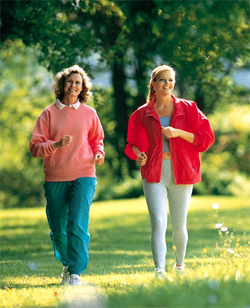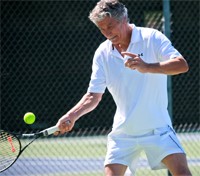|
Neighborhood Exercise
Author:
Stan Reents, PharmD
Original Posting:
05/06/2007 10:55 AM
Last Revision: 01/23/2019 09:44 AM
 "Neighborhood exercise" is a term I will use to describe any kind of low-tech exercise you might do if you started at your front door and simply used the streets and sidewalks in your neighborhood as your exercise route. This might be something as basic as walking your dog. "Neighborhood exercise" is a term I will use to describe any kind of low-tech exercise you might do if you started at your front door and simply used the streets and sidewalks in your neighborhood as your exercise route. This might be something as basic as walking your dog.
Neighborhood exercise is not only appealing to many people, but, I feel it should be encouraged more than it is. Marketing research shows that most people don't care to drive more than 5-6 miles to go to a health club. If the distance is greater than that, generally, they don't maintain a regular exercise program even if they do join.
BENEFITS OF NEIGHBORHOOD EXERCISE
• Convenience: It's a lot more convenient -- and certainly cheaper! -- to exercise in your neighborhood than to join a gym. You don't have to pack up a change of clothes. You don't waste time driving to and from the gym, or waiting on a machine or treadmill once you get there.
• You're outdoors: Personally, I'd rather do anything outdoors than inside a crowded gym. If you're on a tree-lined street or path and far away from diesel-powered trucks, the air is fresh and clean. Researchers from the University of Michigan have shown that your brain reacts differently to urban environments vs. natural outdoor environments. The relaxing aspect of walking in a natural environment gives your brain a chance to recharge (Berman MG, et al. 2008).
• Health benefits: Exercise recommendations for otherwise healthy adults are to obtain 30 minutes of moderately-intense exercise on at least 5 days per week. Most often, "moderately-intense" exercise is described as brisk walking. Also, getting 15-30 minutes of sunlight (on your skin) is enough to activate vitamin D in your body which, surprisingly, many people are lacking. Thus, outdoor exercise can improve your health in a variety of ways.
• "Green" Exercise: You may not have heard of "green" exercise. This term has been used to describe outdoor exercise...ie., interacting with nature. It was coined in 2003 by Jules Pretty, PhD, and Jo Barton, PhD, at the University of Essex in the UK (see: www.GreenExercise.org). It turns out that exercising outdoors -- in natural places -- has positive effects on your mood. Dr. Barton and Dr. Pretty have published dozens of studies on this. They have shown that exercising in "green spaces" has a positive effect on mood regardless if that space is in an urban setting (think of Central Park in New York City), or, in the wilderness (Barton J, et al. 2010). Researchers in South Korea had college students walk once per week in an on-campus forest (and one additional walking session per week) and found a significant improvement in depression (Bang KS, et al. 2017). The effect of exercising in nature is even more pronounced if near a body of water (Barton J, et al. 2010). The potential benefits that exercising in nature has on depression are so significant that the term "forest therapy" has evolved (Lee I, et al. 2017).
• Meet new people: Ever notice that when you're walking or jogging in your neighborhood that other people seem to be more likely to smile and say hello? Of course, if you are racing along on the sidewalk on your bike or rollerblades, then you might make some enemies with people who are just walking. But, certainly you're more likely to meet new people if you're outside as opposed to sitting on the couch in your house.
MAKING NEIGHBORHOOD EXERCISE WORK FOR YOU
Maybe going for a walk or a jog every day by yourself is not very appealing to you, or, maybe you are looking for a change from the same old boring routine. If so, then consider some of these ideas:
Set a new goal each time:
You'll be surprised how your motivation changes when you set new goals. For example, it could be as simple as increasing your daily walk by 1 minute each day. Or, to make the same daily route more interesting, tell yourself to keep walking until, for example, you spot 5 people jogging, or identify 3 houses with bikes or vehicles with bike racks parked in front. (Now you've located some potential new exercise partners!). If you live in an urban area, keep going until you locate a new coffee shop or bookstore or art gallery.
You can also use some web sites to help you set goals. Here are several:
Wear some fitness technology:
Wearable fitness gadgets have gotten very popular in the past few years. So, not only do you have the option of a pedometer or a heart rate monitor, but, fitness bands you wear on your wrist, and, even exercise clothing now has sensors that can give you feedback on your current level of activity.
Wear a weighted vest:
There are several brands of vests with pouches so you can add weights. Wearing a vest like this can add a new dimension to your routine. It will increase your workload, and, in turn, how many calories you burn.
Find a partner:
Find someone who likes the same activities that you do. One way to find an exercise partner is to use a web site:
Hire a personal trainer:
Maybe there is a park close to your house where you can work out. Some personal trainers might meet with you outside of a traditional gym or health club. Several organizations have search tools for finding a certified personal trainer in your area:
ORGANIZED NEIGHBORHOOD EXERCISE
If you are looking for groups to exercise with, check local magazines or the web site Meet Up for walking clubs, hiking clubs, biking clubs, rollerblading events, neighborhood 5-K's, etc. You can also stop by a local bike shop or tennis pro shop and ask about group events in your area.
Moms with newborns and infants may want to check out these web sites:
• Baby Boot Camp (www.BabyBootCamp.com) caters to moms with young infants. (It was originally launched in 1997 under the name StrollerFit; the name was changed in 2001.) It is now a national franchise. It promotes exercise for moms with newborns and infants. According to their web site: "StrollerFit instructors hold nationally-recognized fitness certifications and are infant and adult CPR-certified. They are also specially trained and certified by StrollerFit. Many instructors have advanced academic degrees in health sciences, fitness and physical therapy."
Some cities offer the option to walk with a physician:
"EXTREME" NEIGHBORHOOD EXERCISE
If you took neighborhood exercise to the extreme, you'd have what is called "parkour." The name means obstacle course in French and the goal of the sport's traceurs, also known as freerunners, is to run, jump, vault, or climb over obstacles such as park benches, fences, trash containers, shrubs, etc., in the most fluid manner possible. Generally, parkour is practiced in an urban setting, where there are more elements to work with.
Since its inception in 1987, it has spread internationally, with groups in Brazil, Britain, Canada, Sweden and the United States. In the US, California has the most, followed by New York and Massachusetts, with a large contingent in Maryland and Virginia. Some of the competitors on the TV show "American Ninja Warrior" participate in parkour.
FOR MORE INFORMATION
Readers may be interested in the following related stories:
EXPERT HEALTH and FITNESS COACHING
Stan Reents, PharmD, is available to speak on this and many other exercise-related topics. (Here is a downloadable recording of one of his Health Talks.) He also provides a one-on-one Health Coaching Service. Contact him through the Contact Us page.
REFERENCES
Bang KS, Lee I, Kim S, et al. The effects of a campus forest-walking program on undergraduate and graduate students' physical and psychological health. Int J Environ Res Public Health 2017; 14(7): pii E728. Abstract
Barton J, Griffin M, Pretty J. Exercise-, nature-, and socially interactive-based initiatives improve mood and self-esteem in the clinical population. Perspect Public Health 2012;132:89-96. Abstract
Barton J, Pretty J. What is the best dose of nature and green exercise for improving mental health? A multi-study analysis. Environ Sci Technol 2010;44:3947-3955. Abstract
Berman MG, Jonides J, Kaplan S. The cognitive benefits of interacting with nature. Psychol Sci 2008;19:1207-1212. Abstract
Lee I, Choi H, Bang KS, et al. Effects of forest therapy on depressive symptoms among adults: A systematic review. Int J Environ Res Public Health 2017;14(3): pii E321. Abstract
ABOUT THE AUTHOR

Stan Reents, PharmD, is a former healthcare professional. He is a member of the American College of Lifestyle Medicine (ACLM) and a member of the American College of Sports Medicine (ACSM). In the past, he has been certified as a Health Fitness Specialist by ACSM, as a Certified Health Coach by ACE, as a Personal Trainer by ACE, and as a tennis coach by USTA. He is the author of Sport and Exercise Pharmacology (published by Human Kinetics) and has written for Runner's World magazine, Senior Softball USA, Training and Conditioning and other fitness publications.
Browse By Topic:
adventure races, aerobic exercise, exercise and health, exercise motivation, green exercise, health and fitness targets, heart rate monitors, pedometers, running shoes, walking
Copyright ©2025 AthleteInMe,
LLC. All rights reserved.
|